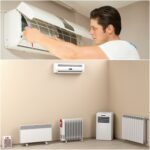Table of Contents
Plenty of issues can arise in homes due to moisture buildup. Excessive moisture may support the formation of mold and mildew, which can harm your house and have negative health effects.
Wooden constructions can rot, paint can peel, and metal pieces can corrode when exposed to moisture. These problems can result in expensive repairs and reduce the comfort level of your house.
To boost indoor air quality, proper ventilation makes your house healthier for you and your family. Prevent damage to your house and make it a more comfortable place to live by keeping enough ventilation.
How to Properly Ventilate Your Home to Prevent Moisture Buildup?
1. Causes of Moisture Buildup
- Everyday Activities
Cooking, taking a shower, and even breathing provide moisture to the atmosphere. Indoor humidity levels are further raised by using equipment like dryers and dishwashers.
- External Weather Conditions
Heavy rains or humid weather can cause moisture to enter your home. This is particularly true if the weatherproofing of your house is poor.
- Poor Insulation and Ventilation Systems
Your house may retain moisture due to old ventilation systems or inadequate insulation. This may result in moist circumstances and raise the possibility of moisture buildup.
2. Consequences of Excess Moisture
- Mold and Mildew Growth
Mold and mildew grow in moist conditions. This fungus can harm and release offensive scents from surfaces like walls and ceilings.
- Damage to Building Materials
Excessive moisture buildup may weaken metal parts, remove paint, and ruin wooden structures. This can cause serious harm over time and costly repairs.
- Health Issues
Health concerns can arise from mold and mildew, particularly for those who have allergies or respiratory problems.
Coughing, sneezing, and trouble breathing are some of the symptoms.

Identify Problem Areas
1. Common Spots for Moisture Buildup
- Bathrooms
Showering, for example, produces a lot of steam, which might cause moisture issues.
- Kitchens
The act of cooking and the use of equipment like dishwashers can contribute greatly to air moisture levels.
- Basements
These places are more likely to be damp and to develop mold since they are frequently cooler and more humid.
2. Signs of Poor Ventilation
- Condensation on Windows
Water droplets on the inside of your windows are a sure sign that the moisture buildup content is too high.
- Musty Smells
A musty smell suggests the possibility of mold or mildew, which is typically a sign of excessive moisture in the air.
Read: Quick Fixes for Instant Home Improvement – Small Changes, Big Impact
Evaluate Existing Ventilation Systems
1. Types of Ventilation Systems
- Natural Ventilation
This is letting fresh air enter your house through the windows, doors, and vents. It is ventilation in its most basic form.
- Mechanical Ventilation
This circulates air using fans and other mechanical devices. Examples include whole-house systems like energy recovery ventilators (ERVs) and heat recovery ventilators (HRVs), as well as exhaust fans in kitchens and bathrooms.
2. Effectiveness of Current Systems in Place
Verify that your exhaust fans are in good operating order and are utilized often.
Make sure air can circulate freely and that no vents are obstructed.
Think about the humidity and general quality of the air in your house. If there are still indications of moisture buildup, it could be time to replace or add more ventilation systems.
Methods to Improve Home Ventilation
1. Natural Ventilation
- Using Windows and Doors Strategically
To create a cross-breeze, open doors and windows on the opposing sides of a room or residence.
This promotes the entry of fresh air and drives out humid, inactive air. If necessary then increase airflow using window fans.
- Ventilation through Architectural Design
Install vents to let hot, humid air escape from places where moisture buildup likes bathrooms and attics.
By opening skylights, warm air can rise and depart, increasing ventilation and lowering humidity.
2. Mechanical Ventilation
- Exhaust Fans
To get rid of steam and moisture buildup from bathrooms, install exhaust fans and use them both during and after showers.
When cooking, use the kitchen exhaust fans and range hoods to release moisture and smells outdoors.
- Whole-House Ventilation Systems
Energy-efficient Heat Recovery Ventilator (HRV) devices replace old indoor air with fresh outdoor air while holding onto heat.
Similar to HRVs, Energy Recovery Ventilators (ERVs) may transport moisture, which is advantageous in extremely humid or dry areas.
Read: Indoor Air Quality – Maintenance Tips for Healthier American Homes
Practical Tips for Reducing Moisture Buildup
1. Daily Habits and Practices
The amount of moisture buildup in your home can be considerably decreased by implementing easy daily routines.
The following are some useful guidelines to follow,
- Using Exhaust Fans
To get rid of steam, always use exhaust fans in the bathroom throughout your shower and for a few minutes following.
The rapid rise in humidity caused by steam from hot water can cause condensation on walls and ceilings, which can encourage the formation of mold. In a similar vein when cooking especially when using the dishwasher or boiling water use kitchen exhaust fans.
By letting out moisture buildup, these fans assist keep it from seeping into other areas of your house.
- Keeping Interior Doors Open
To promote improved ventilation throughout your house, keep interior doors open.
Enough ventilation is necessary to distribute moisture and keep it from moisture buildup in one place, such as kitchens, laundry rooms, or bathrooms.
Doors that are left open let air flow freely lessening the possibility of moist areas that might harbor mold and mildew.
- Using Dehumidifiers
Install dehumidifiers in moist spaces like laundry rooms and basements, or wherever where there is a tendency for increased humidity levels.
By taking moisture out of the air, dehumidifiers help with the maintenance of a dry and comfortable atmosphere.
It is important to routinely empty the water collection container to maintain the best performance and stop mold from growing inside the dehumidifier.
Consider installing dehumidifiers around your house to control humidity levels if you live in an extremely humid area.
Home Maintenance and Upgrades
Controlling moisture levels can be made easier by routine home improvements and upkeep.
Here are some important things to think about,
- Sealing Leaks and Cracks
Check the area around windows, doors, and foundations for leaks or cracks, and then fix them.
Water can seep into your home through even tiny cracks, raising the moisture buildup. To keep your house dry, caulk or weather-stripping should be used to plug these gaps.
Check locations where there are leaks regularly, including the roof, the area surrounding faucets, and pipes, and take quick action to fix any problems found.
Read: Home Maintenance Apps and Tools to Simplify Your Life in the USA
Seasonal Considerations
Seasonal variations happen with proper ventilation techniques.
Here are some suggestions for controlling moisture and preserving year-round high-quality air.
1. Winter Ventilation Tips
- Balancing Ventilation with Energy Efficiency
Maintaining proper airflow and heat conservation in your home is a must during the winter.
To bring in fresh air and allow moisture to escape, open the windows for brief periods. However, shut them before the home gets too cold.
To eliminate moisture from bathrooms and kitchens without losing too much heat, use exhaust fans. Make sure your house has sufficient airflow and is well-insulated for keeping heat within.
- Preventing Condensation on Windows
Make sure the humidity levels in your house are maintained during the winter to avoid buildup on windows.
Monitor the humidity level inside using a hygrometer, and try to maintain it between 30 and 50%.
If condensation forms, remove it right immediately to stop the growth of mold.
Use window insulation film to avoid humidity and help keep interior temperatures constant while reducing heat loss.
2. Summer Ventilation Tips
- Maximizing Natural Ventilation
Make the most of natural ventilation to enjoy the warm weather. To induce cross-breezes which help in cooling your house and removing moisture buildup, open your windows and doors.
To improve ventilation and make sure that air is moving through your house smoothly, use box or window fans.
- Using Air Conditioning Systems Efficiently
In the summer, air conditioning systems may help in controlling humidity and temperature.
To improve its performance, make sure your air conditioner is well-maintained and that the filters are clean.
To lower humidity levels without overcooling, turn on the “dry” mode on your air conditioner if it is available and set the temperature to a reasonable level.
To maintain the cool, dry air inside when the air conditioner is operating, shut windows and doors.
Bottom Line
Begin by identifying the areas that are difficult and inspecting your existing ventilation systems.
Improve airflow and lessen moisture buildup by putting daily routines and practices into place, doing routine maintenance, and thinking through essential modifications.
Get professional guidance and services that are customized to your unique requirements if you have major concerns or are unclear about the best answers for your property.
By taking these precautions, you and your family can create a healthier environment and safeguard your house from issues caused by wetness.
Read: Water Damage Prevention and Maintenance Tips for USA Homes











